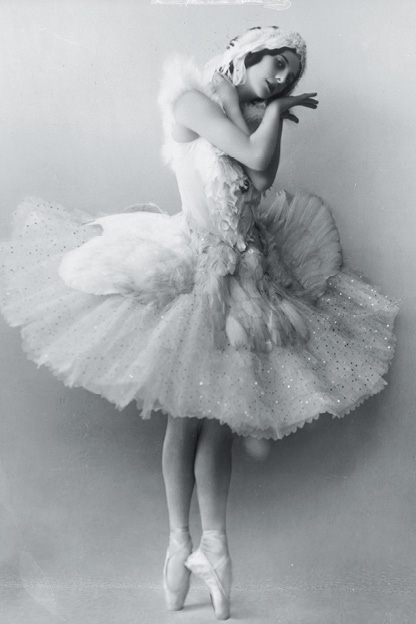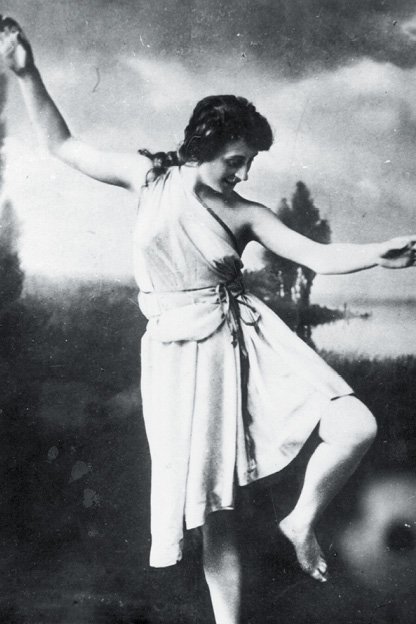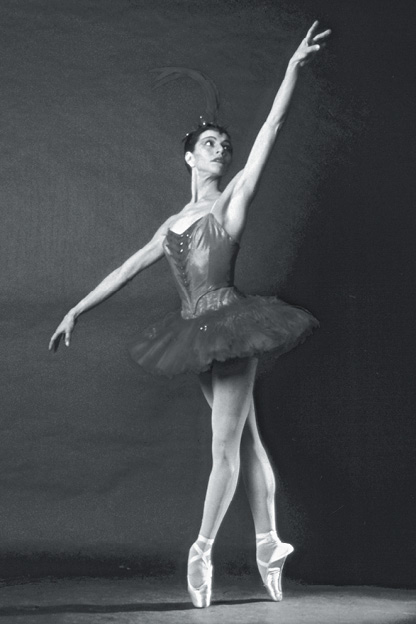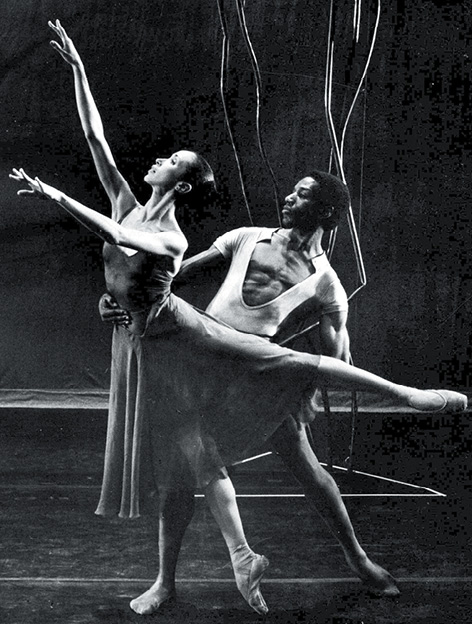Anna Pavlova, Isadora Duncan, Maria Tallchief, and Virginia Johnson

ANNA PAVLOVA

ISADORA DUNCAN

MARIA TALLCHIEF

VIRGINIA JOHNSON
Hillary and Chelsea
Chelsea
Born in St. Petersburg, Russia, in 1881, Anna Pavlova was raised in poverty by her mother, a washerwoman. Anna and her mother always believed she was intended for greatness. As a child, Anna saw her first ballet, The Sleeping Beauty, and made up her mind: She wanted to be a dancer.
Accepted for training at the Imperial School of Ballet in St. Petersburg just a few years later, Anna was overjoyed. So was her mother, who must have felt validated having proof of her daughter’s extraordinary potential.
From that moment on, ballet and dance took precedence over everything else in Anna’s life. She matched her talent with her tireless work ethic and curiosity. As Anna supposedly said, “No one can arrive from being talented alone. God gives talent; work transforms talent into genius.” By her midtwenties, she had become a prima ballerina, and danced the famously difficult role of Giselle with the Imperial Ballet.
At a time when most ballet dancers remained firmly within their discipline, Anna studied Polish, Mexican, Indian, and Japanese dances. When she did dance ballet, she focused on a simpler style than was in fashion, allowing her to show more emotion through her performances. She introduced new audiences to her version of ballet, traveling the world from New York to Tokyo, and on the silver screen as one of the first dancers ever to appear on film. Her most famous variation, and one she frequently performed on tour, was choreographed specifically for her: the Dying Swan. She is believed to have performed it four thousand times. Anna was renowned for her intensity and her grace. She should also have been known for the bravery it took to develop her own style and to eventually start her own ballet company—a rarity for any dancer at that time, particularly a woman.
Anna famously danced until her death—in fact, some argue she danced herself to death. As the star of her own company, she likely felt enormous pressure to keep performing in order to attract audiences and sell tickets to support herself, her dancers, and the orphanage for Russian refugee children she’d founded in Paris. Reportedly, a few weeks before she died, she refused surgery that might have saved her life though likely would have ended her career. One legend says that in her final performances audiences could see the blood seep through her pointe shoes onto the stage, proving her uncompromising dedication. I thought of Anna when I would wrap my toes at home, hoping to hide from my mom the toll that dancing was taking on my feet. I also knew I would never be as talented as Anna, so it would be highly unlikely that I would ever face a choice between my health and showing the world my ballet genius!
Born a few years before Anna and in San Francisco, Isadora Duncan, like Anna, was raised primarily by her mother after her parents’ divorce. Unlike Anna, Isadora was largely self-taught—she had taken ballet lessons at nine years old before deciding the form was nothing more than “affected grace and toe walking” that produced “artificial mechanical movement not worthy of the soul.” When I mentioned Isadora to my Grandma Dorothy, she remembered seeing old photographs of Isadora and thinking how glamorous and unbowed she looked. I had to look up “unbowed” in the dictionary. Once I had, I agreed.
Isadora wanted the world to return to an appreciation of classical lines and natural form, and based her dancing on those principles. In the late nineteenth century, American audiences largely rejected her early efforts, and, at twenty-one, Isadora used her scant savings to travel to England on a cattle boat, hoping to find a warmer reception.
European audiences quickly embraced Isadora’s barefoot, corset-free, more relaxed style; American audiences would eventually do the same. In 1905, in St. Petersburg, Isadora gave a performance based on her manifesto, “Dancer of the Future.” She believed dance needed “to become again a high religious art as it was with the Greeks,” in part to ensure it never became “mere merchandise.” Anna Pavlova was still living in St. Petersburg at the time that Isadora introduced her new interpretation, and as a young dancer, I desperately wanted to believe she was in the audience. (I’ve never found any evidence to support that hope, but still love to imagine it!)
Isadora’s St. Petersburg performance was met with lavish praise and vehement condemnation—a success, since her goal had been to spark conversation. Isadora appeared to be neither overawed by the praise nor discouraged by the criticism; she simply continued to create.
Onstage and off, Isadora wanted to “dance a different dance.” She lived her life fearlessly. Isadora never married the fathers of her children and declared herself a “revolutionist,” as she said true artists are; all were uncommon choices for women in the early twentieth century. When a tragic car accident resulted in her two children and their nurse drowning in the Seine River in Paris, she channeled her grief into her work. She pushed her choreography, staging, and costumes into new territory, and opened dance schools around the world. She moved to Moscow in 1921, captivated by the social and political revolution unfolding in the Soviet Union and determined to translate her outrage over social injustice and human suffering into dance.
She later married Russian poet Sergey Aleksandrovich Esenin. Though she still objected to the institution of marriage, it was the only way he could travel with her on her newest United States tour. This time, she was greeted with hostility and false accusations that she and her husband were both Bolshevik spies. When she left, she vowed: “Good-bye, America, I shall never see you again!” Back in Europe, Esenin struggled with his mental health, eventually dying by suicide.
Isadora spent her final years in France. She was killed when the scarf she was wearing was caught in the wheels of a car. Both she and Anna died while still performing, and both far too young: Anna was forty-five and Isadora fifty. Anna brought ballet to the world and expanded the definition of what ballet could be. Isadora proved that other forms of dance besides ballet could be critically and commercially successful. They opened doors for classical and modern dancers alike, both helping to create the dance of the future.
Hillary
The first famous woman I ever saw in person who inspired me was Maria Tallchief, one of America’s first prima ballerinas. Maria was born in Fairfax, Oklahoma. Her father was a full-blooded Osage Indian. When Maria was three years old, her mother enrolled her in ballet lessons; her sister, Marjorie, would later follow. Before long, they were dancing at county fairs and rodeos. (“Rodeos petrified me,” Maria remembered. “Long-horned bulls lumbered by so close behind the grandstand I was sure I’d get gored waiting to go on.”)
After her family moved from Oklahoma to Los Angeles, Maria experienced the feeling of not fitting in for the first time. Other students teased her about her name, made “war whoops” when they passed her in the hallway, and asked her if her father took scalps. That painful experience would stick with her the rest of her life. Throughout her dancing career and into retirement, she advocated for celebrating and preserving Native American history and culture.
Her big break came in 1942, when she was hired as an apprentice with the Ballet Russe de Monte Carlo, one of the most famous ballet companies in the world at the time. When the company director suggested that Maria change her last name to Tallchieva to sound less Native American and more Russian (a lot of American dancers adopted Russian stage names), she refused; she was proud of her name and her heritage.
Maria’s star was on the rise at a critical time for American ballet. While living in New York, she met the choreographer George Balanchine. He would become her husband and she his muse. Balanchine choreographed iconic roles that showcased Maria’s extraordinary technique and artistry: Stravinsky’s The Firebird, Tchaikovsky’s Swan Lake and “Dance of the Sugar Plum Fairy” in The Nutcracker.
As for me, I started taking ballet at our local dance studio when I was seven. I liked to imagine myself becoming a real ballerina like Maria, whom I saw on television—probably on The Ed Sullivan Show, which my family watched every Sunday night. One day my mother told me that Maria would be dancing in Chicago; she hoped we could go. That was a big deal, since I had never been to a live professional performance of any kind. She had to ask my father, who totally controlled the purse strings, if he’d give her the money to buy two tickets. Somewhat surprisingly to me, he agreed to pay for the tickets and drive us back and forth to Chicago, since my mother didn’t get her license until I was in high school.
Many years later, in 1996, Maria Tallchief came to the White House when she received a Kennedy Center Honor, and I had the chance to tell her how seeing her dance had inspired me.
Chelsea
I was lucky enough to meet Maria when I was a teenager, and to pay tribute to her years later at an event celebrating George Balanchine. The groundbreaking American choreographer is often credited with casting Maria in the roles that helped make her a star, though she was just as instrumental in shaping his career; without Maria, it’s hard to imagine Balanchine. In her memoir, Maria Tallchief: America’s Prima Ballerina, she vividly described the roles she danced and her travels around the world; she also took on complicated, difficult topics, including her relationships, her miscarriage, her feelings about being Native American, and aging.
Like Maria, I am thankful for the teachers I had who prized the best and also valued those of us who gave it our all while gently and consistently reinforcing that we had no professional future in ballet. At Washington School of the Ballet, where I started in the middle of eighth grade, our teachers rarely showed us old videos of variations or ballets. They wanted us to internalize their teaching and direction and then make it our own. They would share stories or impressions from their experiences and their favorite students and dancers. No one’s name came up more frequently and to greater praise than Virginia Johnson’s, an alumna of the school who broke barriers for black ballerinas and dancers. But Mary Day, the school’s cofounder and still director when I studied there, had not always been supportive of Virginia. Back in the 1960s, she had given Virginia a scholarship, praised her dancing, and then abruptly told her upon graduation that she would never get a job in ballet, leaving it implied in big bright lights that it was because of her skin color. The racism was clear.
Virginia’s parents expected her to go to college. Yet, not long into her freshman year, she realized how much she missed dancing and left, hoping to join the Dance Theatre of Harlem. It was the first classical ballet company started by a black American dancer, the extraordinary Arthur Mitchell, and centered on black American dancers. Mitchell had been the first black principal dancer at New York City Ballet and, after the assassination of Dr. Martin Luther King Jr., he decided to start a ballet company in the neighborhood where he had grown up. Virginia learned from Mitchell and then later went on to become one of Dance Theatre of Harlem’s first stars.
Virginia danced everything from classical ballets to Balanchine. Her dancing career lasted far longer than many others because she was simply that good. After she retired, she founded and edited Pointe magazine, a publication that focused on ballet and preparing young dancers for professional careers. Eventually, she rejoined Dance Theatre of Harlem, ultimately becoming its artistic director at Arthur Mitchell’s request. Virginia paved the way for a generation of dancers whose talent the world might have otherwise missed out on. Misty Copeland, the first black woman ever to be a principal dancer for American Ballet Theatre (and the first professional ballerina my daughter Charlotte was aware of) told Virginia: “There wouldn’t be a Misty Copeland without a Virginia Johnson.” Misty added that Virginia “gave the dance world this vision of what black dancers are capable of.”
Anna, Isadora, Maria, and Virginia each captivated audiences with their brilliant performances. Not only that, they possessed the genius and boldness to redefine what dance could be. It is impossible to imagine ballet or modern dance without these trailblazers, for what they did and for the generations of dancers they inspired, including those of us (like me) who would never ascend to their heights and could only marvel at all they accomplished.